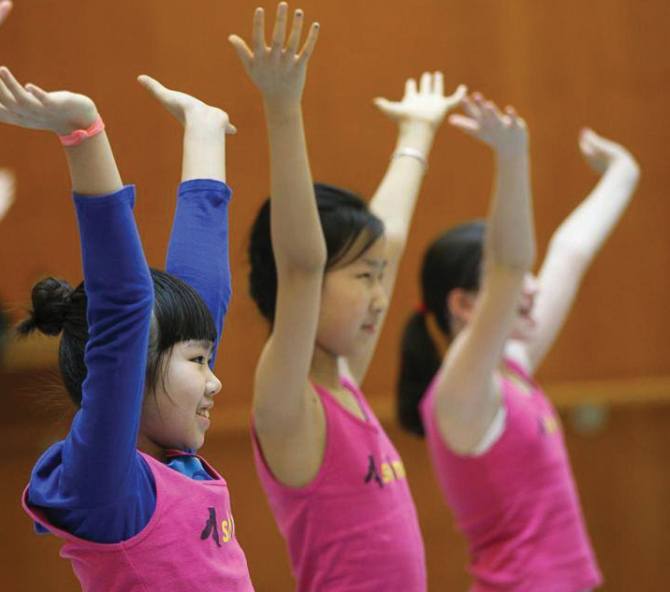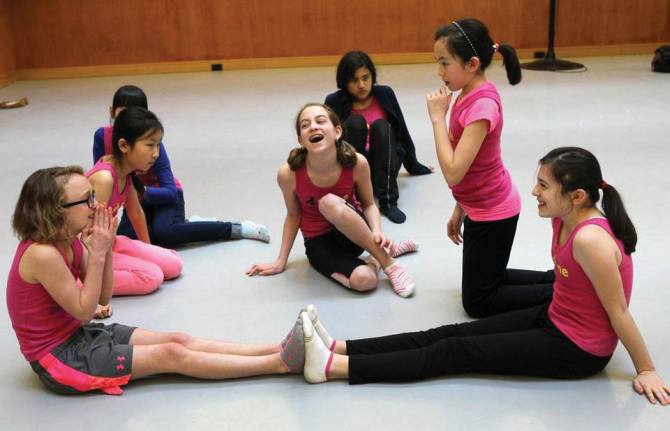Simanta Roy
Simanta Roy meets Kirin Sinha, who is turning how to teach girls to SHINE in math on its head, with dance
In a dance studio in Cambridge, Massachusetts, this spring, about 15 middle-school girls met once a week to learn something atypical for walls lined with ballet bars: Math.
Under the direction of recent MIT graduate Kirin Sinha and other young women who served as volunteer mentors, the girls performed their way to a better understanding of geometry, algebra, and other mathematical concepts for about 10 weeks.
The free afterschool programme founded by Sinha in 2012 is called SHINE. It aims to 'Support, Harness, Inspire, Nurture, and Empower' girls aged 10-12 to learn math, an area where studies show that society believes boys have the inborn edge.
Sinha is working to break that stereotype.
"I personally don't believe there is a difference in math ability between girls and boys," she tells India Abroad.
She is walking the walk. Earning degrees in theoretical mathematics and in computer science and electrical engineering -- with a minor in music -- from MIT, she now plans to earn two master's degrees in advanced computer science and mathematics from Cambridge University in the UK.
 |
With SHINE, she focuses on the malleable age that studies show girls are most influenced by gender-based social expectations and peer pressure: When they hit puberty.
"Middle school is a time when girls are supposed to be picking up their confidence and building notions of who they are," Sinha says. "Girls are bombarded by the media and society with the idea that girls shouldn't be good at math -- and if they are good at math, they will look or act a certain undesirable way."
That's why she believes it's important to begin to effect change at that point in the female brain's development.
As a young girl, Sinha excelled in advanced mathematics and remembers often being the only girl in her math classes. Though she consistently did well in them, she recalls being baffled and confronted by the fact that more girls weren't in these higher-level arithmetic classrooms with her.
Her experience isn't an uncommon one, even now. A recent National Centre for Education study highlighted the stark gender gap that exists in STEM fields. It pointed out that although women make up approximately 57 per cent of all undergraduate degree recipients in the US, 77 per cent of all engineering and engineering technology bachelor's degrees are earned by men.
One place where younger Sinha did feel comfortable in the spotlight and able to cast aside her shyness was in the dance studio. She took her first dance class at age 3 and went on to study ballet, jazz and Bharata Natyam. She performed classical Indian dance competitively and professionally, which she attributes to her confidence in other areas of her life, including academics.
That is why she rendered dance imperative to SHINE'S kinaesthetic curriculum -- that is, learning by doing a physical activity as opposed to a lecture or demonstration.
Please click NEXT to continue reading
Dancing with math: If X were a twirl and Y a jump
Image: Kirin Sinha founded SHINE in 2012Simanta Roy
During the dancing portion of every lesson, groups of girls practice performing in front of the other girls," Sinha says.
Mentors, or young women pursuing STEM fields who volunteer to participate in the programme, are responsible each session for running a kinetic math game, assisting in leading dance choreography, and then helping small groups of girls work through a set of math problems.
Take, for example, the equation 3x + y, where, say, x represents a twirl move and y represents a jump. The girls would kinaesthetically mirror the equation by creating a simple dance of three twirls followed by one jump.
To further internalise the concepts, "mentors can then go in and change the equations," Sinha says.
For example, if the mentors modify the equation by adding a set of parentheses, to make it "3(x + y)," then the "girls will have to dance out the new choreography and understand what changed and why."
The act of incorporating dance in learning, Sinha and the mentors noticed, palpably shifted the girls' self-confidence levels in the math classroom.
Emily Benz, a sophomore at MIT studying electrical engineering and computer science, was a SHINE mentor this spring and is working with executive director Sinha to expand the programme. She describes the 10-week transformation a student in her group underwent: "Originally, (she) was very shy, hesitant to speak up in our small group. However, as the programme continued she was often leading the group in explaining how to solve a problem or answering a question."
Please click NEXT to continue reading
Dancing with math: If X were a twirl and Y a jump
Image: A snapshot from SHINE sessionsSimanta Roy
At the beginning and end of the programme, the girls are given both a math skills assessment and a confidence assessment so as to measure improvement in those areas.
To quantitatively gauge their confidence levels at the start of the course, Sinha says, "We ask them things like, on a scale of 1 to 10, how willing are you to do a solo in front of the group? Or, explain a problem to the group?"
Not only did the students see a 273 per cent increase in their problem-solving skills this year but a 110 per cent increase in confidence levels, as well.
The differences aren't just on paper. Benz describes observing the dramatic behavioural changes on one particular SHINE student: "On the first day, it became very clear this girl did not want to be there. She was quiet and didn't know anyone else. The first few sessions were hard for her, as she was nervous and very quiet during the activities. She often would sit away from the other girls and keep to herself, only participating in the activities when directly asked to."
On the last day, the change was unmistakable: "At the final performance, I noticed this girl smiling and proudly dancing on stage. She was actively participating and making jokes with the other girls."
Even the girl's parents gave a rave review of the programme, saying that, by the end, their daughter was ecstatic to attend each session.
"Her transformation in attitude and confidence was one of my favourite parts of SHINE this year," Benz says, noting that some changes are about giving the girls the confidence to try in the face of the unknown. "When I helped grade the entrance exams, I noticed the girls would often look at a problem, not understand right away, and skip it completely. In the post test, I could see the girls try every problem, no matter how challenging."
SHINE is not just about feeling empowered to solve problems, though, but also about being nice to one another. "There aren't a lot of women in STEM fields, so they tend to be competitive with one another," Sinha says.
SHINE instead encourages the girls to treat each other with support, kindness, and respect.
Please click NEXT to continue reading
Dancing with math: If X were a twirl and Y a jump
Image: A snapshot from SHINE sessionsSimanta Roy
During the dancing portion every lesson, we have little competitions to see who can cheer the loudest for one another," Sinha says.
SHINE fosters collaboration by rewarding the girls with paper "stars," which they can trade in for prizes at the end of the programme. "Stars are not only given for progress, but for teamwork and helping other girls," Sinha adds.
The programme, the mentors hope, will further a cause they feel strongly about: Changing how girls view girls in STEM fields.
"Girls sometimes have these preconceived notions of what a woman in STEM might look like," Sinha says.
According to a 2005 survey by the National Centre for Women and Information Technology, when grade school girls think of computer scientists, "They think of geeks, pocket protectors, isolated cubicles, and a lifetime of staring into a screen writing computer code."
Benz, whose dream job is "designing electronics to be used in schools as learning tools or for kids with disabilities," describes her own struggle with self-confidence in eighth grade.
"When I qualified to join the math team, I was embarrassed and felt ashamed to have my name read over the announcements," she says. "I turned down the invitation because it simply was not cool for girls to join the team."
Benz believes SHINE provides confident, friendly, and positive examples for young girls interested in math and science. "The girls can see how we were able to fight the stereotypes and find success, while still being cool," she says with a smile.
So, what lies ahead for SHINE?
"This summer is all about expansion," Sinha says.
They are hoping to eventually open SHINE branches in New York City, Chicago, San Francisco, Atlanta, and even as far away as the UK and South Africa.
"Female empowerment for me has really become a passion," Sinha adds. "I want women to be in STEM careers so they can be a part of the decisions that change the world."





Comment
article